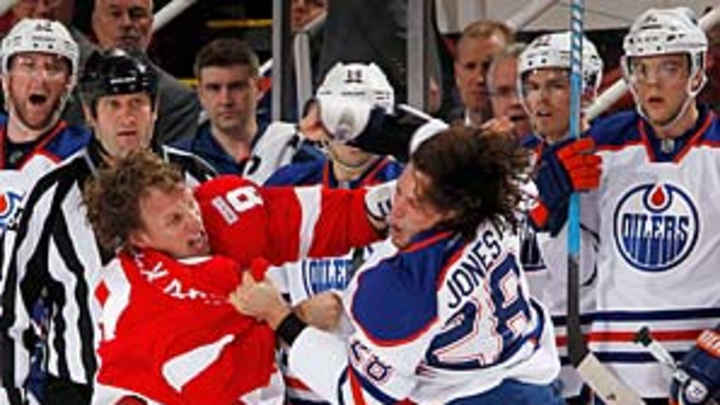Goon may be a relic on arrival

It is certainly an unsettling environment with different touch points of emotion, from the deceased tough guys to the star players sidelined across the continent in various states of fogginess. How much is too much -- and that cuts both ways in terms of protectionism and pugilism -- and what is the proper course of action? And how can any meaningful concern over concussions not include the inherent dangers in fighting? Not just the punches absorbed, but the helmetless takedowns and body slams that end many of today's melees? These are the issues that the powers that be in junior hockey are mulling over.
Let's be clear, I am not a bleeding heart pacifist when it comes to fighting in hockey and I come by my sensibilities honestly. I've written here in the past that the NHL should stop apologizing for what it isn't and embrace what it is -- warts and all. Our game remains the purest blend of speed, skill and savagery in any sport, where breathtaking grace coexists alongside belligerent gravitas. I experienced full-fledged bench-clearing bouts and line brawls at the NHL level, played with Tiger Williams and Bob Probert (GALLERY:NHL's most notorious enforcers) and used my blocker as a weapon countless times on teammates in practice and opponents alike. In the broadcast booth, on many occasions I've enthusiastically pointed out how the fans were standing and cheering in unison during a fight.
Growing up as a young fan, my point of reference was the 1970's NHL where fighting as an intimidation tactic propelled Philadelphia's Broad Street Bullies to successive Stanley Cup Championships in 1974 and 1975, making those Flyers the toast of the town in Philly and the bane of every other franchise. They took the rough and tumble element of the game and morphed it into a tactical advantage. No more settling old vendettas in the vein of Eddie Shore and Gordie Howe, which was one-on-one retribution with stick, elbow or fists. The Flyers introduced contrived chaos to the equation. The natural course of action became natural selection.
From there, we've seen goon tactics move from enforcers enlisted to protect stars in the 1980's to rambunctious role players in the '90s whose main task was to answer the bell when the situation warranted or the coach deemed it necessary to change a game's momentum, to the 2000's phase of the one-dimensional designated hitter in which one team's tough guy fought the other's simply 'cause they oughta and then the game moved on.
In today's cap era, having a roster spot taken up by a guy who can punch but can't play doesn't make fiscal sense to many people. Still, the players who perform that duty for a team have typically been held in high esteem, thus the rationale for a movie like Goon.
SEVERYN:My life as an enforcer
Despite the sanitizing of the sport over time and the current conjecture at the major junior level, the New York Rangers lead the NHL in fights and are enjoying one of their best seasons since winning the Cup in 1994. Conversely, the perennially relevant Detroit Red Wings eschew fighting as a part of their DNA, yet their youngsters Justin Abdelkader and Brendan Smith -- two former college players, no less, who came from leagues (CCHA, WCHA respectively) where fighting leads to automatic ejection and game misconduct -- have dropped their gloves recently, demonstrating that they won't be intimidated at this level. It's a test that every young player must pass. I think that's the way fighting in hockey was meant to be -- two players settling something between them and proving their willingness to engage in fisticuffs versus willfully and repeatedly throwing down.
The requirement is still there that if you play a feisty game, you'd better prove you can back it up, especially as a raw rookie like Smith or an emerging, energetic twenty-something like Abdelkader, who took up boxing to be better prepared for what awaited him in the NHL.
Hockey Canada and USA Hockey are looking at it from the perspective of getting rid of staged fights and the mayhem mongers who repeatedly wreak havoc that is meaningless and unnecessary. Spontaneous bursts of bare knuckle brawling might still have a place. I hope so because it is far easier to change the sport's rules than its culture. This is the next step in the evolution of fighting and its place in the game, which is just another point on the continuum. Certainly, taking only the "unnecessary" fights out of the mix doesn't reconcile with player safety and the concussion epidemic. Getting rid of the nonsense, however, is a logical beginning.
Is that enough? Well, history will judge these blustery times as a perfect storm or truly the moment when the winds of change gave new meaning to the lives of three players who played the hard way and died too soon while pop culture fare like Goon became a retrospective piece before it even hit theatres.
